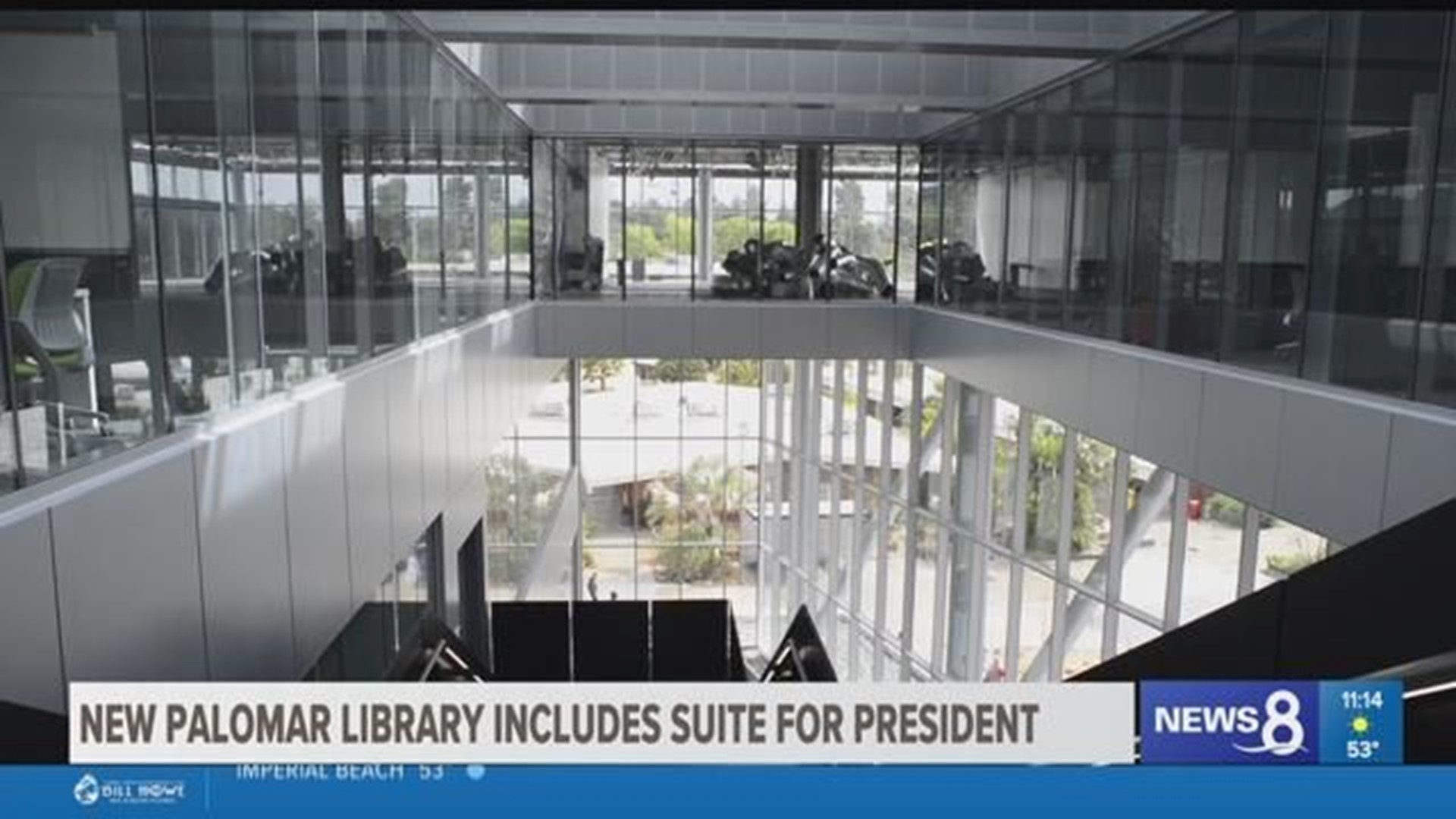By Megan Wood | inewsource
As officials prepare for the Friday grand opening of a $67 million library at Palomar College, crews have already begun demolishing part of the building’s top floor to build President Joi Lin Blake an office suite.
Design of the nearly $1 million remodel started more than a year ago when architectural plans were ordered. The college’s governing board later approved a $797,000 contract to build the presidential project.
The suite will include Blake’s office, space for two staffers, and a conference room, restroom, work/break room and waiting area. The money to pay for it is coming from a $694 million bond measure voters approved in 2006.

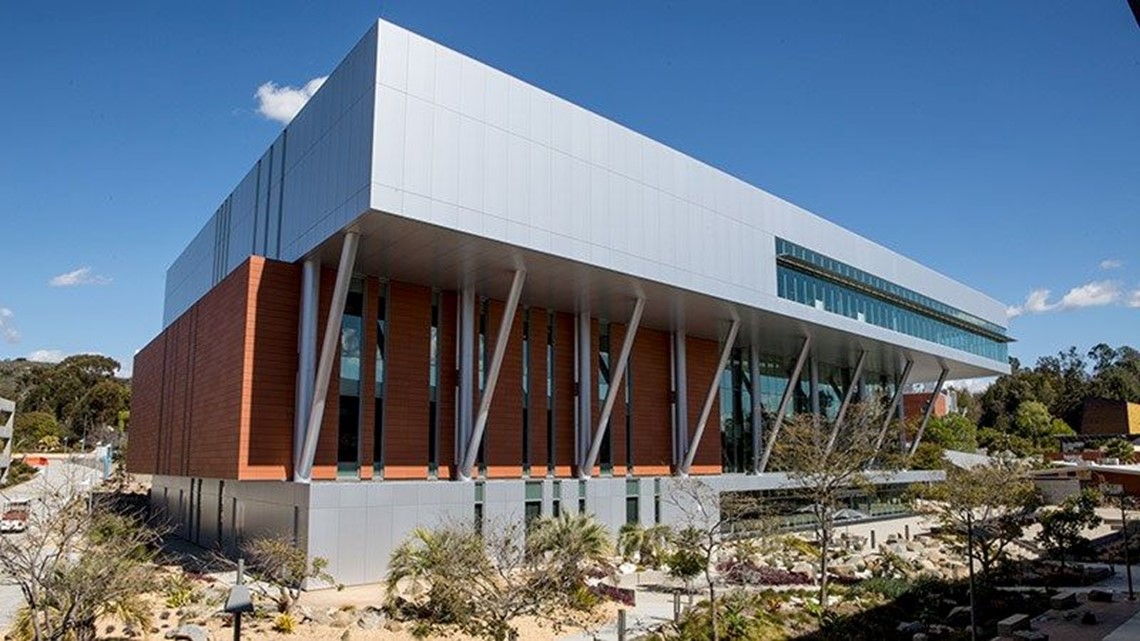
The outside of the $67 million Palomar College Library is shown on Feb. 16, 2019. (Megan Wood/inewsource)
A few professors have objected for months to spending taxpayer funds on the project when Blake has been talking about budget problems at the district, which serves about 30,000 full- and part-time students. Two college district board members also opposed approving the suite’s construction contract in December, saying they weren’t given enough details about the project.
“It just seemed that it was a sudden vote, that things had already been put in place before we had a chance to get more information,” board member Nina Deerfield told inewsource.
“Could we have a built new classrooms? Equipped science labs? What did we give up for that (presidential office suite)?” she said.
David Kline , a vice president with the nonprofit California Taxpayers Association, questioned spending tax dollars from a bond measure on a remodel that was never in the plan voters approved.
“When you start changing things after the fact or adding offices for the executives instead of more classrooms for the students, that creates a problem,” Kline said. “It is a classic bait-and-switch kind of approach.”
Blake and her spokeswoman, Laura Gropen, declined repeated requests by inewsource for an interview about the library and office suite construction. In an email Tuesday, Blake said the project’s expense was “well within reasonable construction costs.”
Gropen took inewsource on a tour of the library and described the cost of Blake’s top-floor office as “minimal” compared to the cost of the whole project. It also was the only suitable place on campus left to accommodate the president, she said.
A district official said in an email two other campus buildings were considered for Blake’s office but were ruled out because they were occupied and didn’t have extra square footage.
Changing the library design
When state architecture officials approved plans for the new library in December 2014, the project’s estimated cost was $49 million. Gropen said the total amount now spent on the building is $67.3 million — including the presidential suite.
Drawings show the area for Blake’s 2,232-square-foot office suite was originally designed to be a reading study room and a meeting room.
Blake’s office is temporarily on the new library’s second floor until the suite is finished this summer. Her office previously was in the old library, which is now vacant.

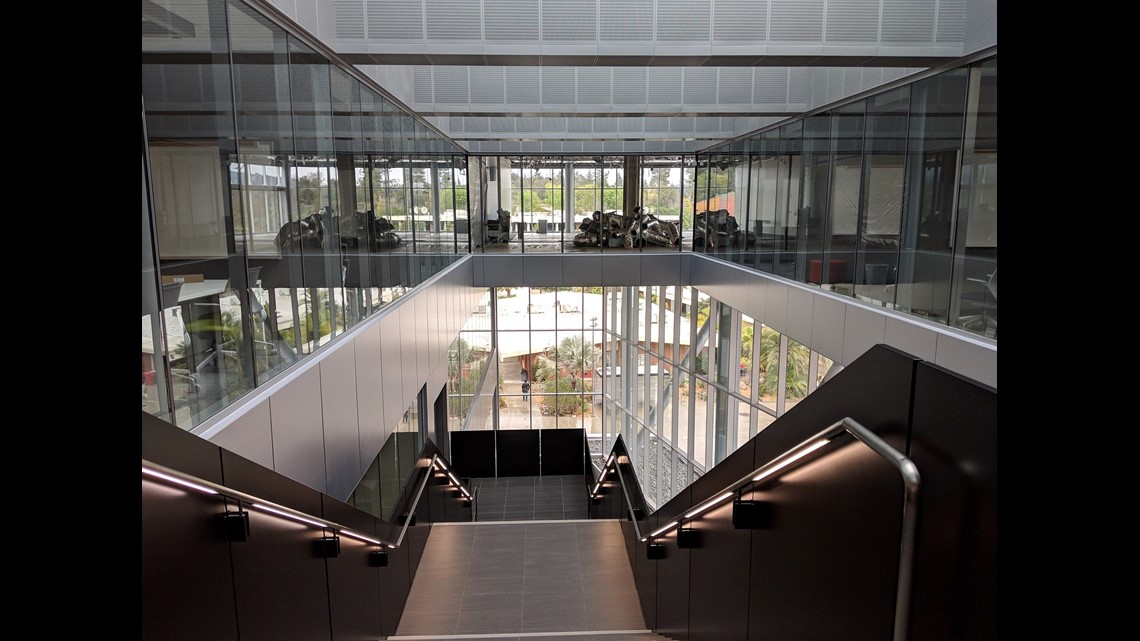
The inside of President Joi Lin Blake’s future office suite is shown above a staircase in Palomar College’s library on Feb. 5, 2019. (Megan Wood/inewsource)
A campus construction plan used to sell voters in 2006 on the Proposition M bond detailed renovating the old library to house all administrative staff, including the president, to create a “one-stop Student Services Center.”
“Unfortunately, the old library just is not large enough to accommodate” what was originally planned, Gropen said. Currently, no plans exist to renovate the more than 50,000-square-foot building, she said.
Tax dollars from the 2006 bond have funded dozens of district projects, including a technology center, planetarium and humanities building on the San Marcos campus. Shannon Lienhart, a math professor there for 27 years, has been vocal in opposing the use of bond money to pay for the presidential suite.
“The point is it's a million dollars, and it didn't need to be spent,” Lienhart told inewsource. “There's a reason why bond money is supposed to be spent on education. Obviously, you have to have administrative buildings for the administrators, but it's mostly supposed to be built for education purposes.”


Palomar College math professor Shannon Lienhart is shown outside of her office on Feb. 4, 2019. In the background is the college’s $67 million library. (Megan Wood/inewsource)
Oversight committee’s role in school bonds
The Palomar College district stretches across North County from Camp Pendleton to Ramona. Homeowners in the district currently pay $20.90 per $100,000 of assessed value each year on their homes to cover the Prop. M bond debt, which will be paid off in 2045. That means a district taxpayer with a home assessed at $500,000 pays $104.50 annually toward the bond.
Under the measure voters approved, the money is to be used to repair and build educational facilities, such as expanding classrooms and labs and upgrading essential infrastructure. It can’t be spent on administrative salaries and operating costs.
Although the college has an independent citizens oversight committee that meets four times a year to oversee Prop. M spending, Gropen said construction contracts and purchase orders on bond-funded projects — including the one for the presidential suite — do not go to the committee for approval. Instead, an overview of ongoing projects are presented to the panel at its meetings, she said.
“They aren't reviewing individual plans of each of the projects,” Gropen said. “They're not going over square footage on each project. They're not approving those plans.”
Kline with the California Taxpayers Association said that could mean there’s a lack of opportunity for oversight members to weigh in on how bond money is being spent.
“The whole purpose of the citizens oversight committee is to have oversight,” he said. “If they aren't presented with the facts in time to actually make any decisions, it defeats the entire purpose.”
Kline said best practices involve bond oversight committees overseeing projects before any construction or changes are approved, so “if something is a bad idea, it can be stopped before any money or time and resources are spent on it.”

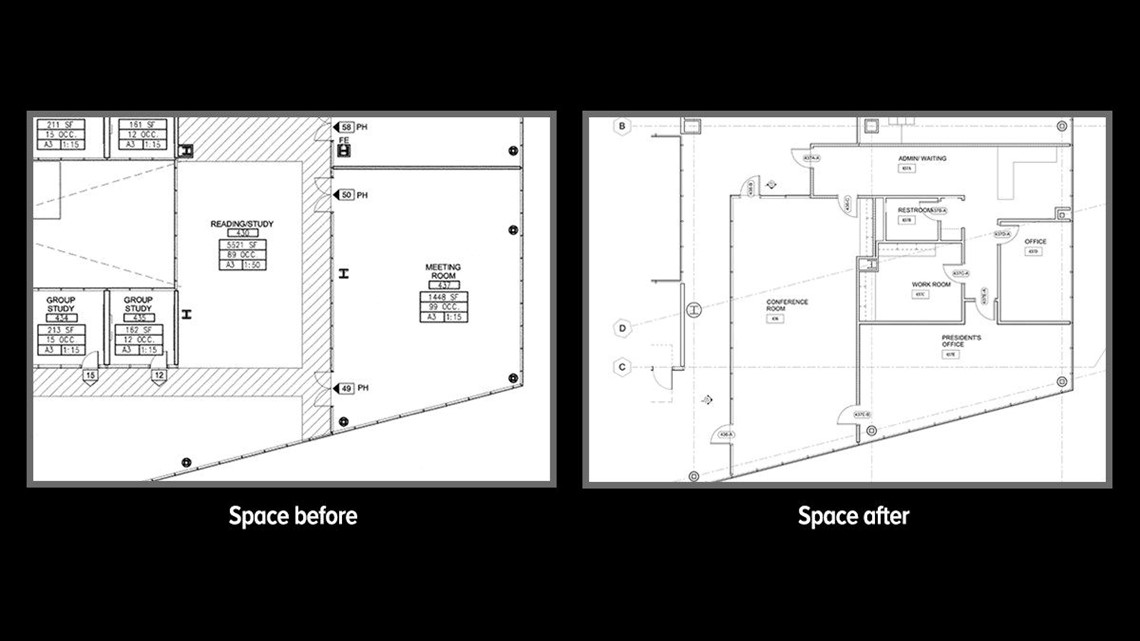
The image above shows the before and after floor plans for Palomar College President Joi Lin Blake’s new office suite. The original design included a meeting room and reading/study room.
Retired engineer Michael Hunsaker of San Marcos serves on the Prop. M oversight committee. He told inewsource he found out about Blake’s office suite from a professor who spoke about it at a September committee meeting.
The college is usually good about spending its bond money, Hunsaker said, but “the economics just don't make much sense” for the last-minute remodel to the new library’s top floor.
“It would have made much more sense to renovate a corner of another building,” he said.
Another bond oversight committee member, Glen Winn, said he’s been briefed on the project several times. In addition to the committee’s oversight, independent audits of the spending are also required, he said.
“There has been no question raised (about) anything that's gone on with Proposition M,” Winn said.
District response to teacher concerns
Blake has been Palomar College’s president since 2016. She told faculty at an annual meeting last August that the college had “barely” balanced its budget, and accomplishing that had required “some serious reductions and leveraging of resources” in the prior year.
Lesley Blankenship-Williams, a professor of life sciences at Palomar, said the budget issues are what have caused some faculty to question the library remodeling costs for Blake’s suite.
“It feels very deceptive. It's a lot of money at a time when suddenly money is short, or it feels short,” Blankenship-Williams said.
Math professorSusan Snow told inewsource “the general sense on campus is that money is very tight.”
“It’s not that we don’t want (Blake) to have an office. And it’s not that we don’t want her to have a nice office,” Snow said. “But in terms of the grand scheme of things, in terms of spending money, it just seemed a little bit greedy, self-serving (and) not in the best interest of the college or the students.”
Three of the college’s five trustees approved the presidential suite construction in December, including board member Mark Evilsizer. He told inewsource Blake’s office should remain in the library and is important because “the president receives a lot of people and represents the district.”

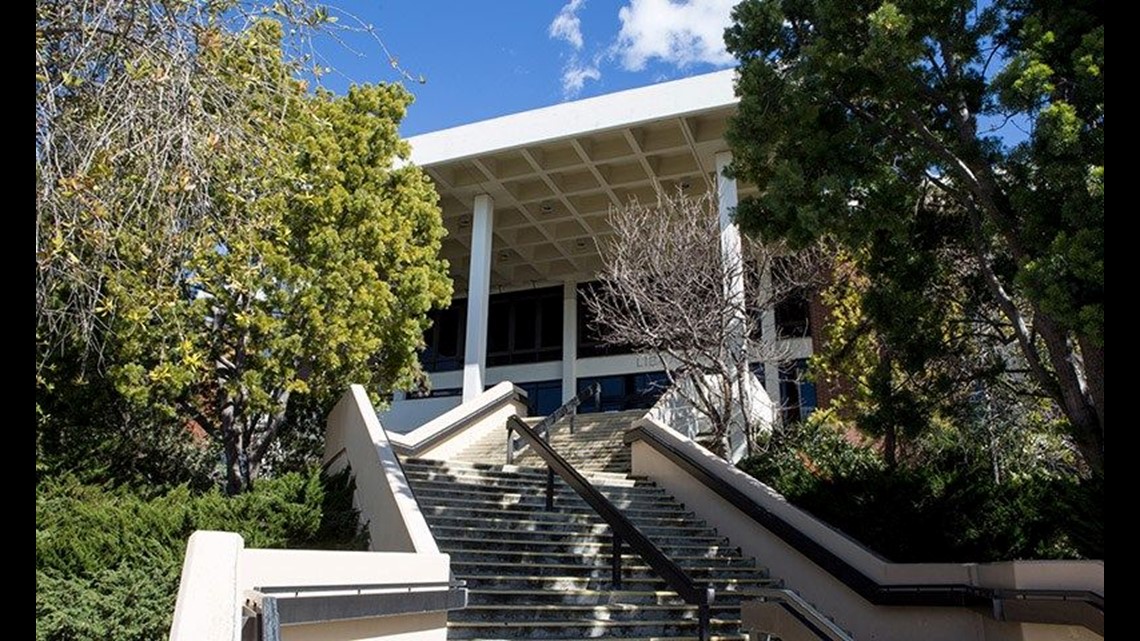
The outside of Palomar College’s old library is shown on Feb. 16, 2019. The building is now vacant. (Megan Wood/inewsource)
Gropen said the district is considering asking voters next year to approve another bond measure. She said it would fund new projects.
Considering the current use of the money, Kline said, “In the long term, taxpayers are going to be less receptive of bonds and all sorts of taxes if the money isn't used the way they were promised that it would be."
Haney Hong, head of the San Diego County Taxpayers Association, raised similar concerns. He said if Palomar is not transparent about how it’s funding the presidential suite remodel, that can “erode trust” with the public and discourage voters from supporting future bond measures.
It also could determine whether his group will endorse future Palomar bond measures.
“How a district performs today, and on projects going on, helps inform us thinking about whether we ought to trust them with tax dollars in the future,” Hong said.
Last year, his group refused to endorse the San Diego Unified School District’s $3.5 billion bond measure because previous bonds were supposed to have paid for many of the proposed projects. Even so, San Diego voters approved the measure.
********
********
inewsource is an independent, investigative journalism nonprofit supported by foundations, philanthropists and viewers like you.
********
Read additional stories on the inewsource.org website.

